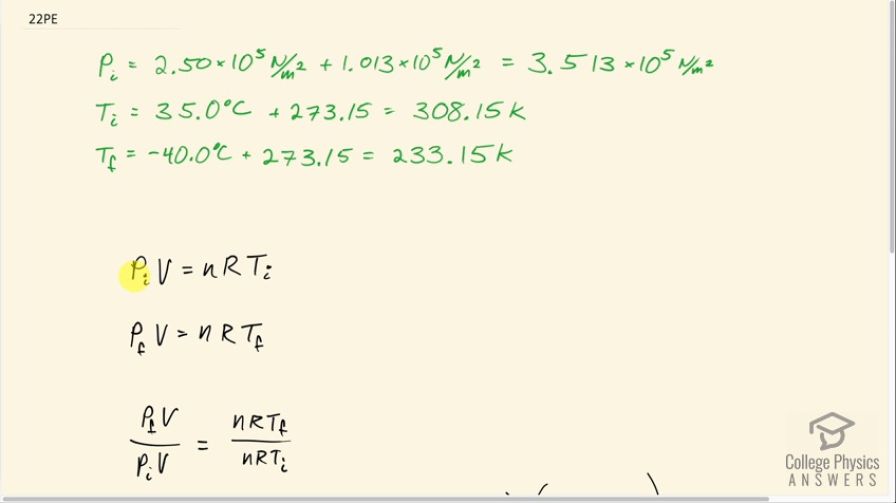Question
The gauge pressure in your car tires is at a temperature of when you drive it onto a ferry boat to Alaska. What is their gauge pressure later, when their temperature has dropped to ?
Final Answer
Solution video
OpenStax College Physics, Chapter 13, Problem 22 (Problems & Exercises)

vote with a rating of
votes with an average rating of
.
Calculator Screenshots
Video Transcript
This is College Physics Answers with Shaun Dychko. The original gauge pressure in these tires is 2.5 times 10 to the five newtons per square meter. Now, the ideal gas law formula requires your pressure to be absolute pressure. So we have to add atmospheric pressure to that to get 3.513 times 10 to the five newtons per square meter. And also, the temperature in the ideal gas formula requires absolute temperature in kelvin. So we add 273.15 to each of these temperatures that are in degrees Celsius to begin with. So initially it's 35.0 degrees Celsius. So we add this conversion and we get 308.15 kelvin and then the final temperature after driving on to the ferry is minus 40 degrees Celsius which is 233.15 kelvin. So, initially, we have the initial pressure in the tires multiplied by the volume equals the number of moles of air molecules times the universal gas constant times the initial temperature. And then after the temperature was down to minus 40 we have some final pressure that we have to find multiplied by the same volume. So this volume does not need to have a subscript on it. There is no need to distinguish it because it's the same volume in both cases. So we just call it V. And likewise, the number of air molecules is the same because the tire does not have a hole in it so there is no escaping air molecules, same, N and the same gas constant but a different temperature T F. Now we can divide these two equations. So we divide the left side. Let's say we have PFV over PIV equals the corresponding ratio of the right-hand side. So that's NRTF divided by NRTI and the common factors cancel and then we multiply both sides by initial pressure and then we solve for final pressure. So the final pressure is the initial pressure times the final temperature divided by the initial temperature. So that's 3.513 times 10 to the five newtons per square meter absolute initial pressure times 233.15 kelvin divided by 308.15 kelvin which is 2.65797 times 10 to the five newtons per square meter. This is not the answer because the convention with tire pressure is that you are always measuring gauge pressure. So the amount by which the pressure exceeds atmospheric pressure. So we have to convert into gauge pressure. And there is no standard way of indicating that your pressure is gauge pressure versus absolute pressure. So I put this little prime symbol here as my way of saying this is a new final pressure, gauge pressure in other words. So we take this answer, subtract away atmospheric pressure and you get 1.64 times 10 to the five newtons per square meter is the new gauge pressure at minus 40 degrees Celsius.

